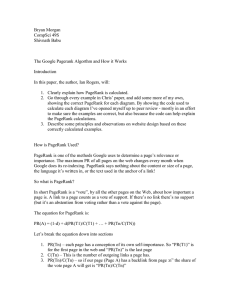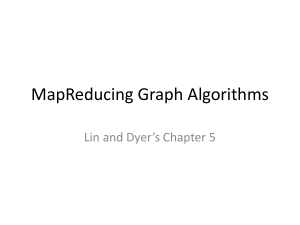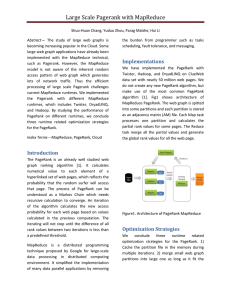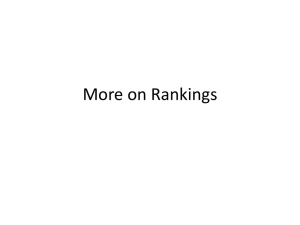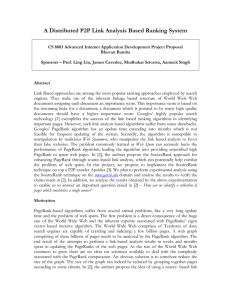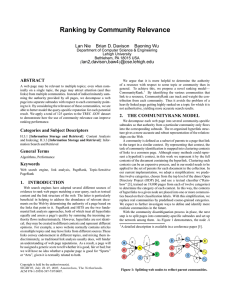sweep-and-visualize
advertisement
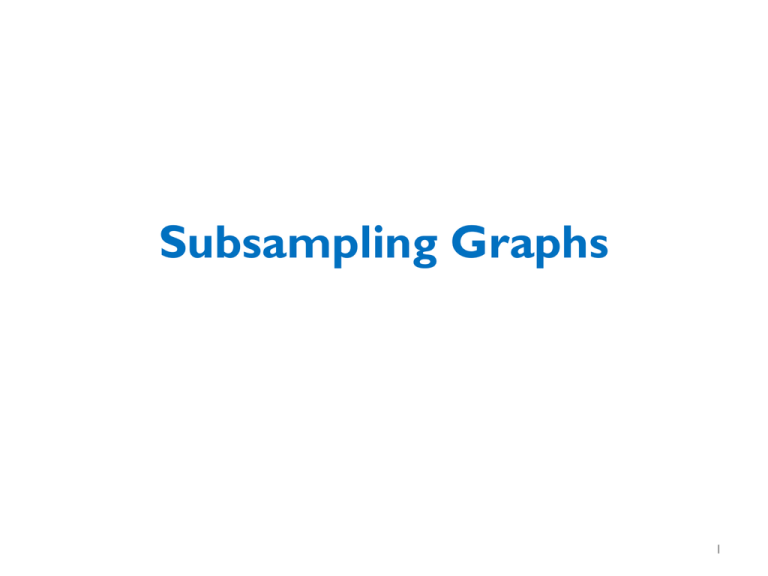
Subsampling Graphs
1
RECAP OF PAGERANK-NIBBLE
2
Why I’m talking about graphs
• Lots of large data is graphs
– Facebook, Twitter, citation data, and other social
networks
– The web, the blogosphere, the semantic web, Freebase,
Wikipedia, Twitter, and other information networks
– Text corpora (like RCV1), large datasets with discrete
feature values, and other bipartite networks
• nodes = documents or words
• links connect document word or word document
– Computer networks, biological networks (proteins,
ecosystems, brains, …), …
– Heterogeneous networks with multiple types of nodes
• people, groups, documents
3
Our first operation on graphs
• Local graph partitioning
• Why?
– it’s about the best we can do in terms of
subsampling/exploratory analysis of a
graph
4
What is Local Graph Partitioning?
Global
Local
5
What is Local Graph Partitioning?
6
Main results of the paper (Reid et al)
1. An approximate personalized PageRank computation
that only touches nodes “near” the seed
– but has small error relative to the true PageRank
vector
2. A proof that a sweep over the approximate
personalized PageRank vector finds a cut with
conductance sqrt(α ln m)
– unless no good cut exists
• no subset S contains significantly more mass in the
approximate PageRank than in a uniform distribution
7
Approximate PageRank: Key Idea
• p is current approximation (start at 0)
• r is set of “recursive calls to make”
• residual error
• start with all mass on s
• u is the node picked for the next call
8
ANALYSIS OF
PAGERANK-NIBBLE
9
Analysis
linearity
re-group & linearity
10
Approximate PageRank: Key Idea
By definition
PageRank is fixed
point of:
Claim:
Proof:
11
Approximate PageRank: Algorithm
12
Analysis
So, at every point in the apr algorithm:
Also, at each point, |r|1 decreases by α*ε*degree(u), so: after T
push operations where degree(i-th u)=di, we know
å d × ae £ 1
i
i
which bounds the size of r and p
13
Analysis
With the invariant:
This bounds the error of p relative to the PageRank vector.
14
Comments – API
p,r are hash tables – they are small (1/εα)
Could implement with API:
• List<Node> neighbor(Node u)
• int degree(Node u)
push just needs p, r, and neighbors of u
d(v) = api.degree(v)
15
Comments - Ordering
might pick the largest r(u)/d(u) … or…
16
Comments – Ordering for Scanning
Scan repeatedly through an adjacency-list encoding of the graph
For every line you read u, v1,…,vd(u) such that r(u)/d(u) > ε:
benefit: storage is O(1/εα) for the hash tables, avoids any seeking
17
Possible optimizations?
• Much faster than doing random access the first few scans, but
then slower the last few
• …there will be only a few ‘pushes’ per scan
• Optimizations you might imagine:
– Parallelize?
– Hybrid seek/scan:
• Index the nodes in the graph on the first scan
• Start seeking when you expect too few pushes to justify a scan
– Say, less than one push/megabyte of scanning
– Hotspots:
• Save adjacency-list representation for nodes with a large r(u)/d(u)
in a separate file of “hot spots” as you scan
• Then rescan that smaller list of “hot spots” until their score drops
below threshold.
18
After computing apr…
• Given a graph
– that’s too big for memory, and/or
– that’s only accessible via API
• …we can extract a sample in an interesting area
– Run the apr/rwr from a seed node
– Sweep to find a low-conductance subset
• Then
– compute statistics
– test out some ideas
– visualize it…
19
Key idea: a “sweep”
• Order vertices v1, v2, …. by highest apr(s)
• Pick a prefix S={ v1, v2, …. vk }:
– S={}; volS =0; B={}
– For k=1,…n:
•
•
•
•
S += {vk}
volS += degree(vk)
B += {u: vku and u not in S}
Φ[k] = |B|/volS
– Pick k: Φ[k] is smallest
20
Scoring a graph prefix
the edges leaving S
• vol(S) is sum of deg(x) for x in S
• for small S: Prob(random edge leaves S)
21
Putting this together
• Given a graph
– that’s too big for memory, and/or
– that’s only accessible via API
• …we can extract a sample in an interesting area
– Run the apr/rwr from a seed node
– Sweep to find a low-conductance subset
• Then
– compute statistics
– test out some ideas
– visualize it…
22
Visualizing a Graph with Gephi
23
Screen shots/demo
• Gelphi – java tool
• Reads several inputs
– .csv file
– [demo]
24
25
26
27
28
29
30
31
32
33
34

